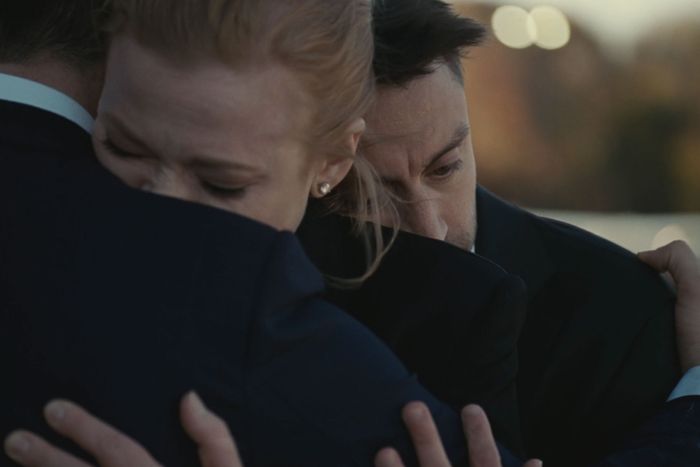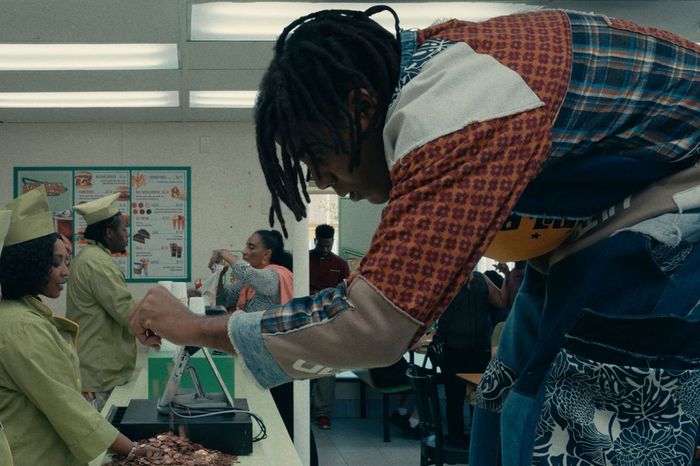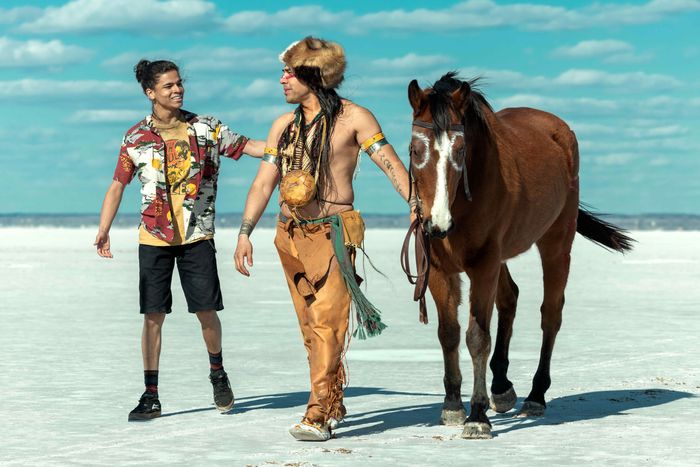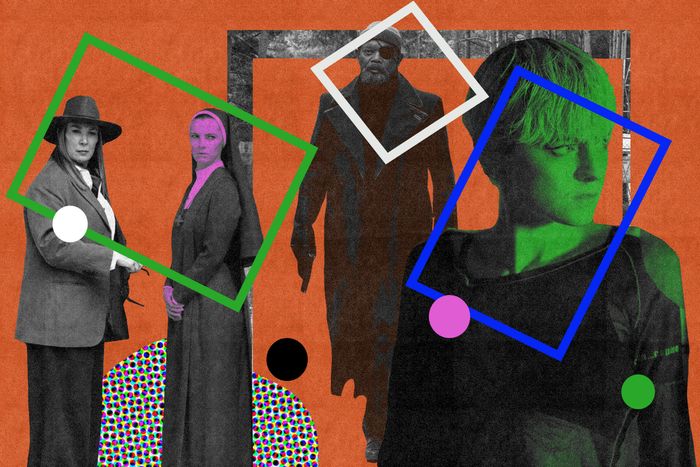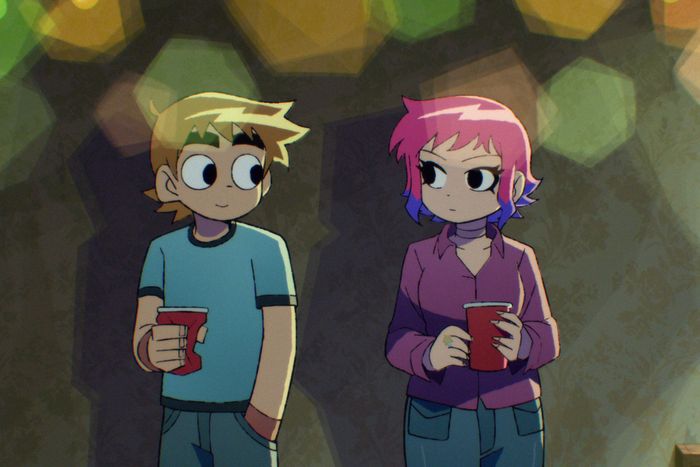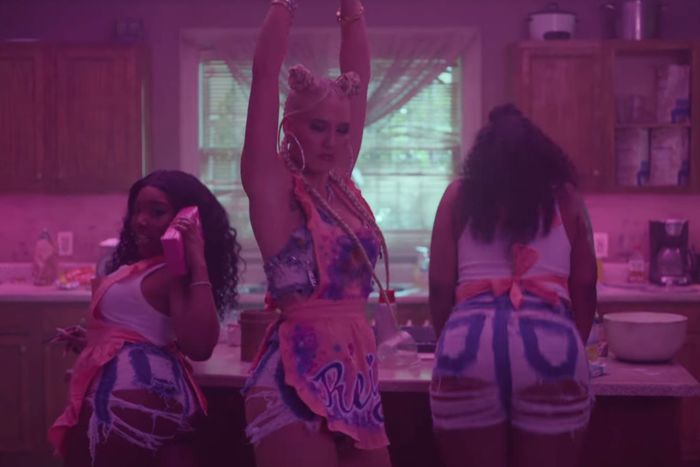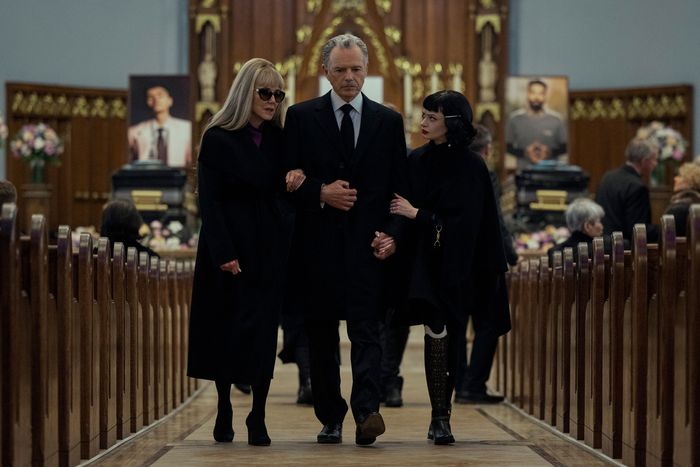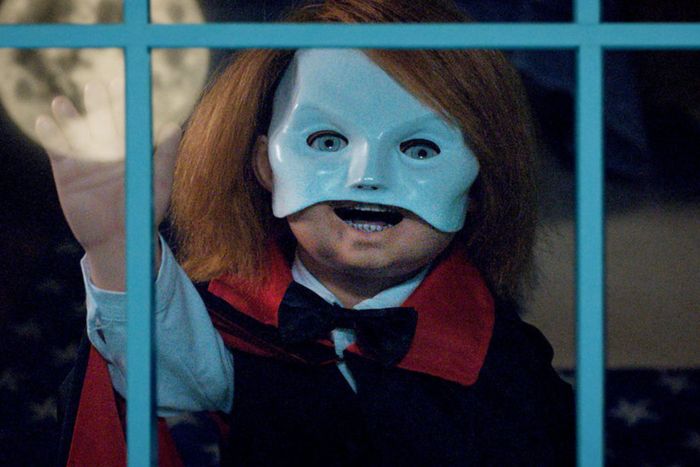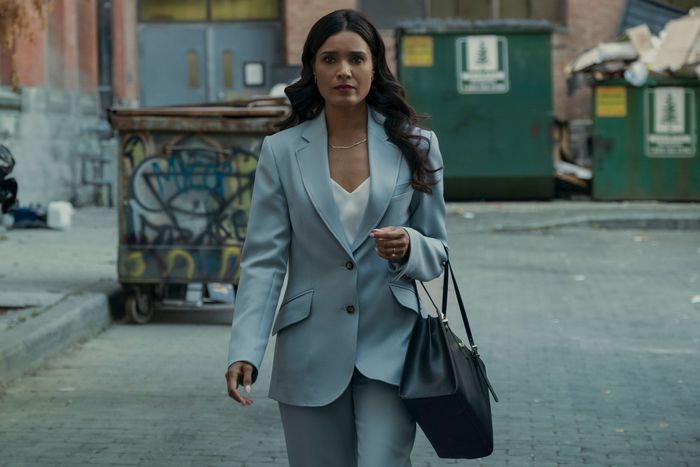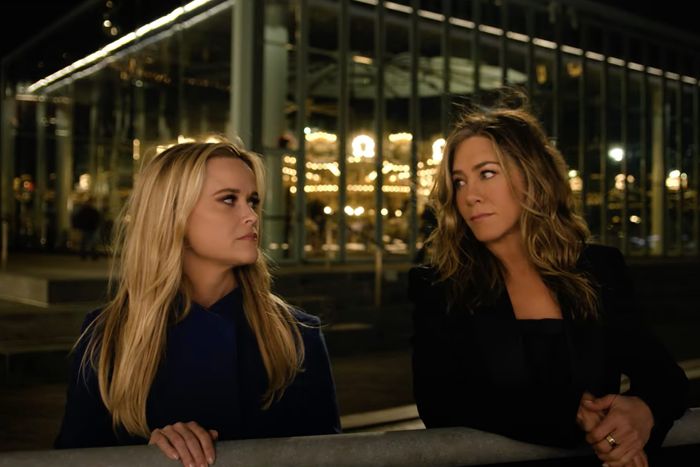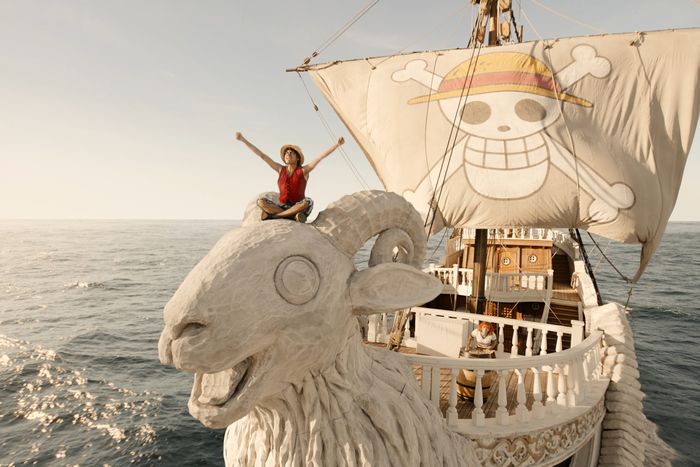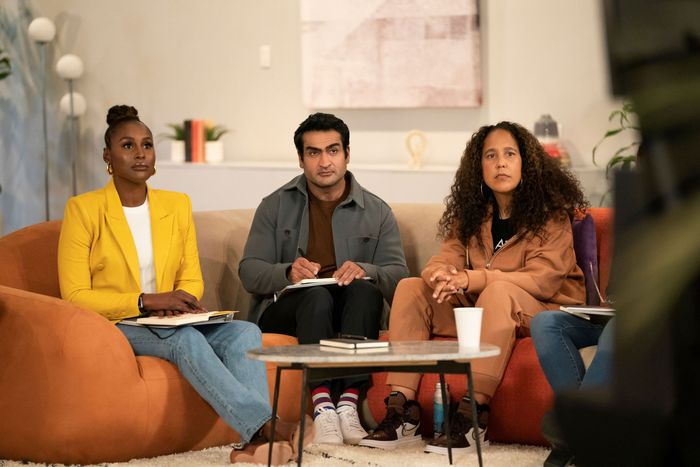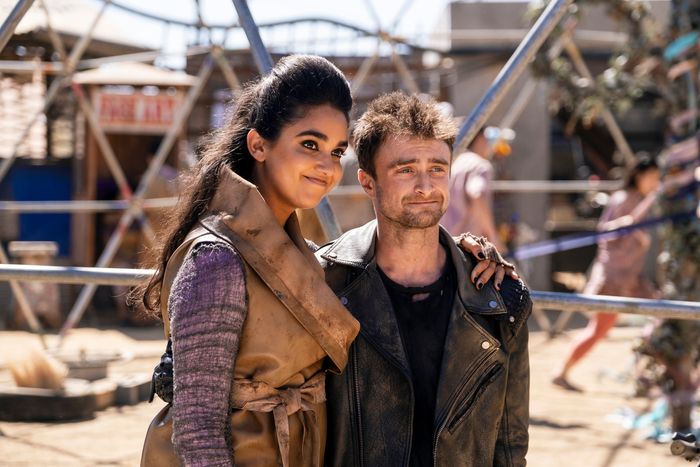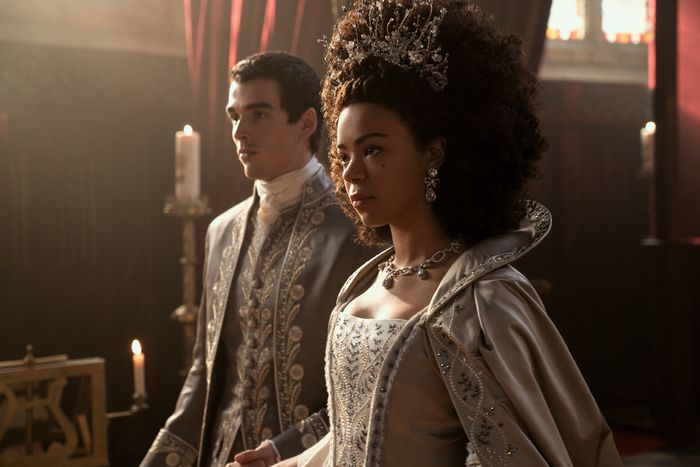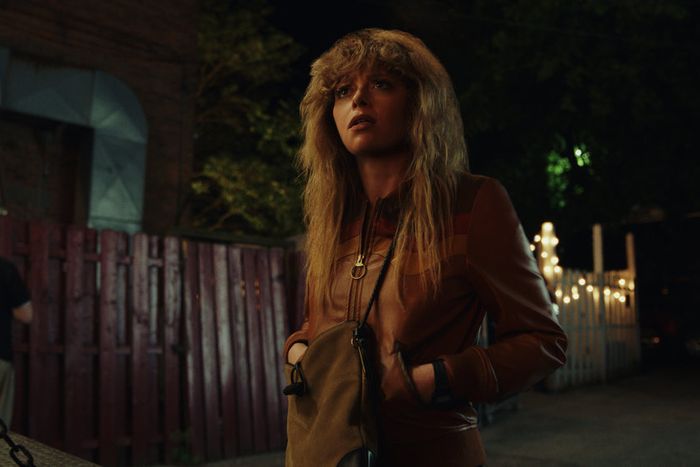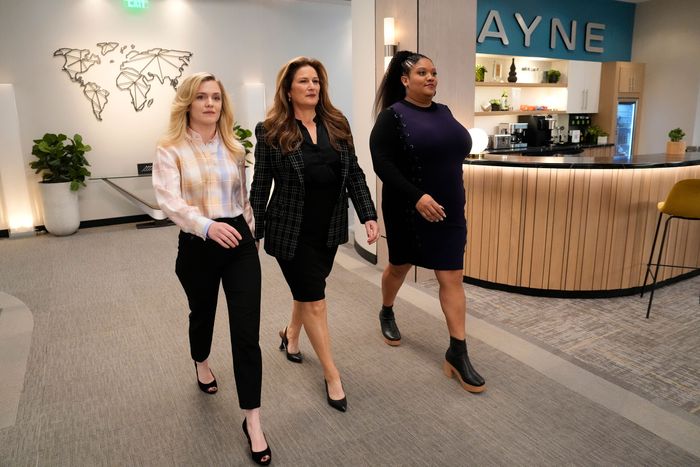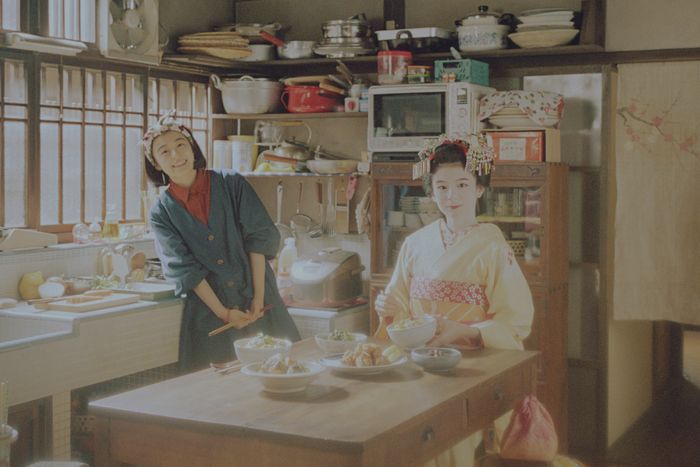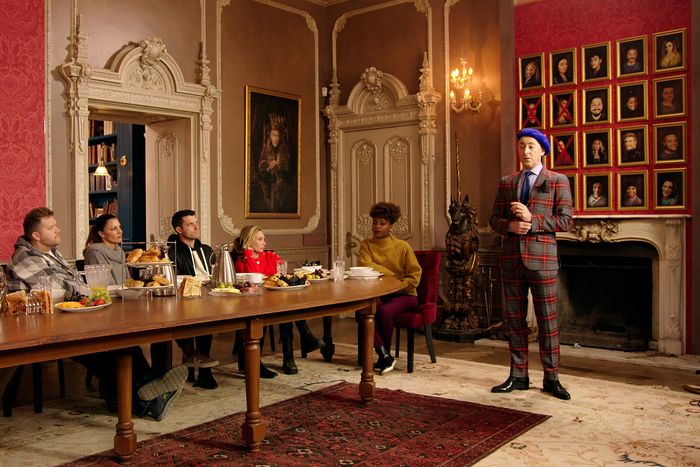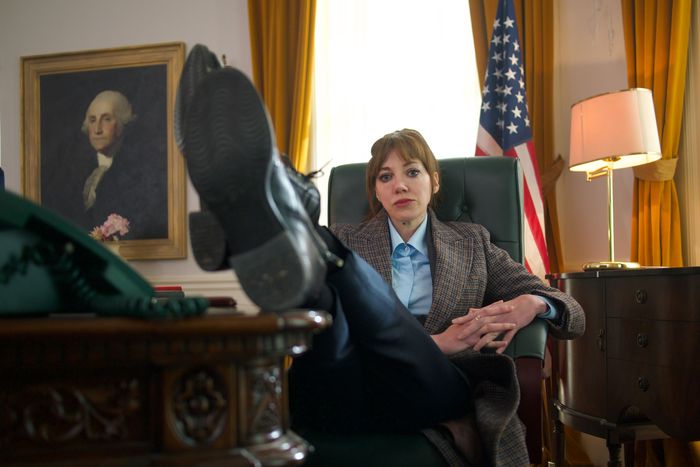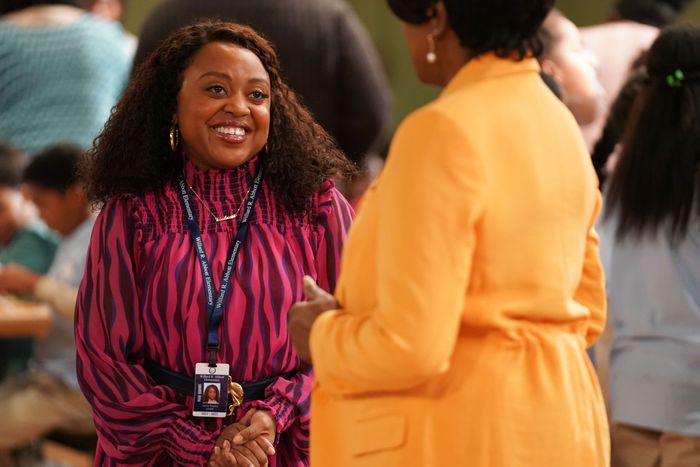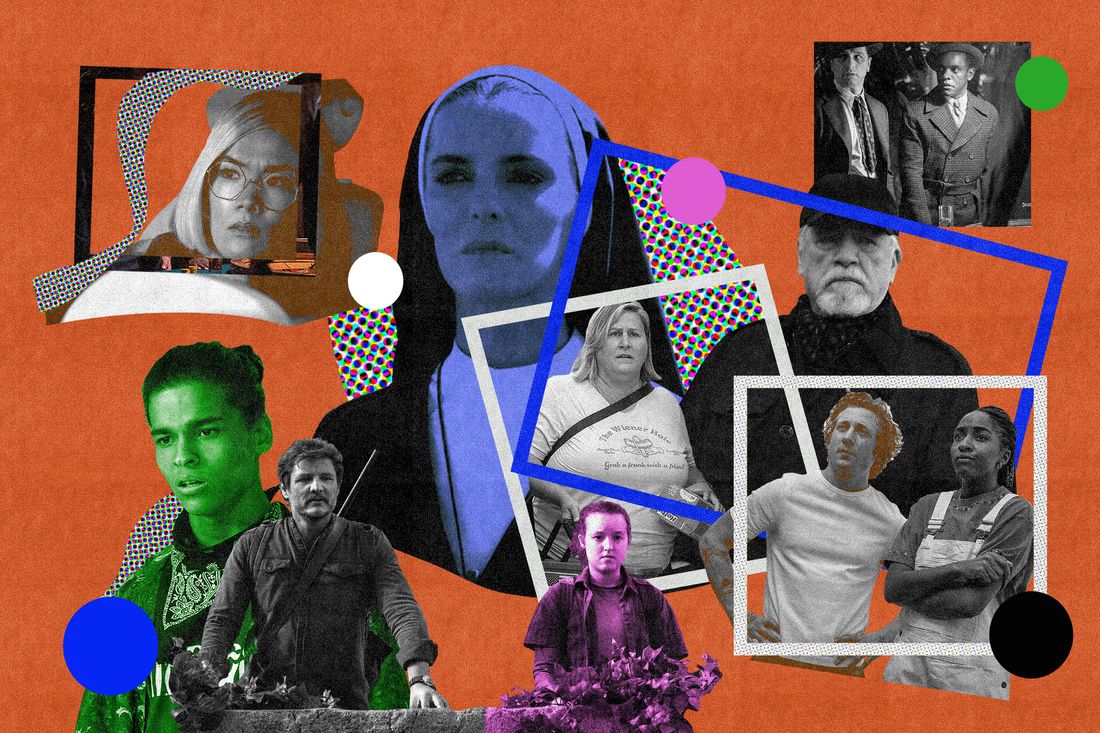
In this article
When looking back on the year in television, it’s tempting to dwell on what was taken from us, whether at the hands of craven capitalism or creator control. A beloved show ending on its own terms is undeniably preferable to, say, a nascent series getting killed by a corporate merger, but it doesn’t change the fact that this year we had to say good-bye to some of the best TV of the last decade, including two series, Succession and Reservation Dogs, that topped of all three of our critics’ best-of lists. Yes, it’s better to have loved and lost, but those losses still sting, especially in an industry that’s openly struggling to navigate its post-peak era.
But as we bid farewell to the tumult of 2023, it’s important to also celebrate what the year has given us: hard-won fair contracts for the people who make the shows we love; pitch-perfect finales followed by surprise renewals for The Righteous Gemstones and Somebody Somewhere, and a less-surprising renewal for The Bear, the other show that landed on all three critics’ lists; new series like Mrs. Davis and I’m a Virgo, which proved there’s still room in this fractured landscape for idiosyncratic, ambitious, and just plain weird TV. All are cause for optimism as we watch the industry attempt to reinvent itself (again), a reassuring affirmation that no matter how chaotic things may get, great TV will always manage to find its way to us.
Jen Chaney’s Top 10 Shows
10.
Beef
When trying to whittle down 2023’s good TV shows to a list of the year’s ten greatest, I consider multiple criteria. A major one is currency: Does the work in question feel particularly of the moment or Zeitgeisty? Beef, the relentlessly tense Netflix limited series from Lee Sung Jin, absolutely checks that box. A half-hour drama whose action is incited by a road-rage incident between Amy Lau (Ali Wong), a businesswoman, mother, and wife, and Danny Cho (Steven Yeun), who works in construction and can’t quite get on the straight and narrow, Beef is a scripted reflection of the anger that has bled into the fabric of daily American life. Wong and Yeun practically lay their spleens on the screen in performances that are unflinching in their capacity to expose the worst of human nature. This is also the only series whose finale features a philosophical conversation between a pair of crows, and I respect that.
Read Roxana Hadadi’s full review of Beef, Erin Qualey’s essay on the season finale, and Nina Li Coomes’s recaps of the series.
9.
The Last of Us
This easily could have been a standard postapocalyptic series about Pedro Pascal and Bella Ramsey running to escape various beasts every week. Instead, series co-creators Craig Mazin and Neil Druckmann, who also helped craft the video game on which this HBO drama is based, took the original source material and built additions onto its core structure. The result is a show about the disastrous effects of a pandemic that landed on TV at a moment when most people were ready to stop thinking about viruses and vaccines, yet still managed to capture widespread attention. That’s because The Last of Us was as much a character study as a work of horror or action, one that established how deeply human beings need each other in the worst of times and their aftermath.
Read Jen Chaney’s full review of The Last of Us, Roxana Hadadi’s essay on the show and American exceptionalism, Hadadi’s interview with co-creator Craig Mazin, and Keith Phipps’s recaps of the season.
8.
Barry
In its fourth and final season, the dramedy from co-creators Bill Hader and Alec Berg finally reveals whether it’s possible for its antiheroic hit man, Hader’s Barry Berkman, to find redemption. The eight-episode journey that answers that question takes some ambitious narrative risks, including multiple time jumps, while remaining fiercely committed to the dark comedy, and sometimes just plain darkness, that have always been central to Barry’s sensibility. The powerful and provocative series finale closes with a peek at a TV movie about Barry’s life that demonstrates how easily and regularly Hollywood sanitizes harsh truths and downplays the impact of violence, two things that Barry the HBO series admirably never did.
Read Roxana Hadadi’s review of Barry season four, Ben Rosenstock’s recaps of the season, and Devon Ivie’s interview with star Sarah Goldberg.
7.
Party Down
The beloved cater-waiter comedy reemerged on Starz more than a decade after its second season ended, but tonally, it didn’t stutter for a single breath. In fact, Party Down may have become even more masterful at depicting the absurdity and tragedy of working in the hospitality business, particularly for the older, original characters still donning pink bow ties for a gig that was supposed to be a pit stop on the way to actual fulfillment. Adam Scott, Martin Starr, Ryan Hansen, Megan Mullally, and Jane Lynch all settle back into a comfortable rhythm with each other, while new additions Zoë Chao, Tyrel Jackson Williams, and Jennifer Garner slide into the group as if they’ve been part of it since the beginning. But the heart of the series remains the perpetually optimistic natural disaster of a human being that is Party Down boss Ron Donald, who, in the hands of Ken Marino, turns an extremely ill-timed bout of food poisoning into one of the funniest, most weirdly heartbreaking television moments of the year.
Read Kathryn VanArendonk’s review of Party Down season three, Erin Qualey’s recaps of the season, Jen Chaney’s profile of Ken Marino, and listen to Jesse David Fox’s Good One podcast interview with star Adam Scott and showrunner John Enbom.
6.
Somebody Somewhere
The mere mention of this show’s name puts a smile on my face, but not because it’s some sappy, cozy concoction that avoids difficult subject matter. The second season of Somebody Somewhere deals with some tough stuff, including unexpected deaths, the energy-draining responsibilities of caring for an aging parent, and, most significantly, the delicate process of maintaining close adult friendships, as embodied by the bumps in the relationship between Sam (series co-creator Bridget Everett) and Joel (Jeff Hiller). Few things on television exude more organic joy than this half-hour slice of Midwest small-town life; it’s a weekly reminder that life, even at its most mundane and frustrating, demands to be embraced.
Read Jen Chaney’s full review of Somebody Somewhere season two and Maggie Fremont’s recaps of the season.
5.
Mrs. Davis
The same year in which artificial intelligence became one of the principal villains in the writers and actors strikes also gave us this totally off-its-freaking-rocker adventure about a nun named Simone (Betty Gilpin, dialed in perfectly to this show’s weirdo frequency) who reluctantly pursues a series of quests at the behest of the titular AI, which has become a more prevalent influence on modern life than Siri and Alexa combined. The series, co-created by Tara Hernandez and Damon Lindelof, does the absolute most and makes no apologies for it, dancing across genres and themes — sci-fi cautionary tale, absurdist comedy, action-thriller, religious meditation — until it arrives at its eighth and final episode, which contains one of the most ridiculous and perfect 11th-hour twists in recent television history. Turns out sometimes TV can still be intellectually challenging and fun as hell.
Read Jen Chaney’s review of Mrs. Davis, Kathryn VanArendonk’s interview with creators Tara Hernandez and Damon Lindelof, and Sean T. Collins’s recaps of the series.
4.
The Other Two
This relentlessly funny penetration of the nonsense fart cloud that hangs over the entertainment industry has always been dense with jokes. But in its third and final season, the writers layered ambition on top of the density, creating elaborate set pieces — a remake of Pleasantville that doubles as a send-up of broadcast TV procedurals, a spoof of Angels in America, a very silly story line about a gay animated character that turned out to be pretty realistic — as well as plot developments that captured both the post-COVID moment and the timeless idiocy of show business. Few comedies in 2023 made me laugh so deeply and so frequently.
Read Brian Moylan’s recaps of The Other Two season three, Jen Chaney’s profile of star Ken Marino, and Ben Rosenstock’s interview with Josh Segarra.
3.
Reservation Dogs
This beautiful and groundbreaking portrait of life on an Oklahoma reservation began as a coming-of-age story about a group of young people itching to leave that life behind, but over the following two seasons, Sterlin Harjo’s refreshingly idiosyncratic series widened its scope to demonstrate that this Bildungsroman is multigenerational. As depicted in rich episodes like “House Made of Bongs,” a Dazed and Confused homage that shows the reservation’s more senior members during their teen years in the 1970s, and “Send It,” an uproarious hospital heist that turns into a meditation on the importance of community, Reservation Dogs ultimately tells us that every one of these Indigenous characters, regardless of their age, is still reeling from loss and searching for a path forward. It’s fitting that the final shot of the series is not of the central four friends — Bear, Elora, Willie Jack, and Cheese — but of four of their older counterparts —Maximus, Brownie, Irene, and Bucky — sitting side by side. They are the elders, and without them, the rez dogs, and Reservation Dogs, could not exist.
Read Kali Simmons’s recaps of Reservation Dogs season three, Matt Zoller Seitz’s interview with director Danis Goulet, and Kathryn VanArendonk’s interview with Dallas Goldtooth.
2.
The Bear
While mulling which series deserved the top two spots on this list, I kept coming back to the same question: Which shows became an obsession for me in 2023? The second season of The Bear definitely did. As hectic, stressful, and claustrophobic as it could get — and I’m just talking about the “Fishes” episode — I wanted to stay in the Chicago-foodie environs sculpted by Christopher Storer for as long as humanly possible. I watched and rewatched its masterfully crafted suitcase episodes, “Honeydew” and “Forks,” and caught new, exquisite details each time. I wanted and still want to hug every single person on this show: earnest and hardworking Sydney (Ayo Edebiri) with her delicious potato-chip French omelets; the deeply flawed and deeply human Richie (Ebon Moss-Bachrach), secret Swiftie; Marcus (Lionel Boyce), who’s discovering a whole world he never knew existed, literally and figuratively; Carmy (Jeremy Allen White), who’s still so terrified of vulnerability and loss of control. I am not joking when I say that not a day goes by that I don’t think of all of them and this absolute gem of a television show.
Read Kathryn VanArendonk’s review of The Bear season two and Marah Eakin’s recaps of the season.
1.
Succession
This is the most boring, unsurprising answer to the question, “What was the best TV show of 2023?” It also happens to be the truth. Nothing else on TV offered such a rich combination of Shakespearean drama and corporate buffoonery. Nothing else demanded to be analyzed so urgently after it was viewed. Nothing else added so many new phrases to my lexicon (“ludicrously capacious bag,” “terrifyingly moseying,” “Meal fit for a king!”) or convinced me that playing a game called Bitey could be freakishly hot. Nothing else was as engrossing as the 62 minutes spent watching “Connor’s Wedding,” a masterfully shot and acted nuptial celebration that turns tragic in real time.
I mentioned the importance of being Zeitgeisty at the top of this list, and Succession, with bull’s-eye accuracy, tapped into the spirit of 2023, a year when rich megalomaniacs at media companies rose up as cultural supervillains. The process of finally finding out who would succeed the late Logan Roy, a fictional human whose death nevertheless inspired actual obituaries, confirmed all of our worst suspicions about how the wildly wealthy and powerful operate behind closed doors. But unlike in real life, watching their behavior was deeply entertaining, profanely hilarious, and unexpectedly moving. Succession taught us how to see the Roys and individuals of their ilk as full, complicated human beings. To its credit, it also never failed to remind us that they would never, ever show us the same courtesy.
Read Kathryn VanArendonk’s essay on the Succession series finale, Scott Tobias’s recaps of season four, Jackson McHenry’s interview with Brian Cox, and Matt Zoller Seitz’s interview with Jeremy Strong; and catch up on the rest of Vulture’s in-depth Succession coverage.
Roxana Hadadi’s Top 10 Shows
10.
A Murder at the End of the World
It would be easy to dismiss Brit Marling and Zal Batmanglij’s latest series as just vibes. Their previous collaborations — Sound of My Voice, The East, The OA — had loud detractors who found the duo’s fascination with cults, sci-fi imaginings, and upending the capitalist status quo too odd. But those people were wrong before, and they would be wrong again to disregard the delicately woven but formidably conceived A Murder at the End of the World. It’s not that Marling and Batmanglij have left behind their interests with this mystery, which follows Emma Corrin’s novelist and amateur detective Darby Hart as she tries to solve a murder at a billionaire’s (Clive Owen) remote Icelandic retreat. But the recurring collaborators make a canny choice by transferring their existing obsessions to recognizable present-day realities: how our reliance on technology has become a kind of shared brainwashing, how we can only imagine a future with the aid of artificial intelligence instead of humanity, how the wealthy become only more clannish as they prepare for a climate-change-ravaged planet. The finale tips heavily into Marling and Batmanglij’s inherent earnestness, but that’s a feature, not a bug. A Murder at the End of the World is never not immersive, and the clarity of its convictions plus the ingenuity of its world-building makes it sneakily one of the pair’s most approachable yet principled works.
Read Nicholas Quah’s review of A Murder at the End of the World and Ben Rosenstock’s recaps of the season.
9.
Full Circle
In a sea of so much sameness this year — police procedurals, series about women fleeing their traumatic pasts, the umpteenth entry in the please-we’re-tired Marvel and Star Wars universes — the dense Full Circle, about a kidnapping, a curse, family secrets, corrupt cops, and contemporaneous colonialism, was like absolutely nothing else. Created and written by Ed Solomon and directed by Steven Soderbergh, Full Circle follows in the footsteps of their previous collaborations Mosaic and No Sudden Move, which also twisted and turned their way through almost too many ideas. The close attention Full Circle demands is earned, though, thanks to the ensemble’s strong performances, including the unforgettably menacing Phaldut Sharma and a going-against-type Timothy Olyphant, and an ending that wrangles the series from the realm of the supernatural to a place more earthly and upsetting. The promises we make and fail to keep have a long memory, and Full Circle wouldn’t let us forget.
Read Ben Rosenstock’s recaps of Full Circle.
8.
Perry Mason
There’s a sad poetic irony to Perry Mason being canceled by HBO during David Zaslav’s cost-cutting tenure, given that its fantastic second season sketched with clarity and fury the amorally capitalist one-percenters who have so long defined the way this country functions. Under the guidance of The Knick’s Jack Amiel and Michael Begler, Perry Mason’s second season grew in scope and ambition, tackling the racist history of Los Angeles, the imbalance of this country’s legal system, and the very real possibility that justice is always an illusion. The season finale is acceptable as a gloomy coda, but Perry Mason now feels like a “what could have been” scenario, a show cut off as it moved from good to great.
Read Kathryn VanArendonk’s full review of Perry Mason season two and Andy Andersen’s recaps of the season.
7.
Dead Ringers
Grotesque can be good, and in the case of Dead Ringers, very, very good. Rachel Weisz delivers a titanic dual performance as twin gynecologists Beverly and Elliot Mantle, two women who have devoted their lives to helping other women have babies. Is that altruistic? Beverly has convinced herself it is, Elliot would outright laugh at the suggestion that she would ever do something for anyone who isn’t Beverly, and Weisz crafts the twins simultaneously as mirror images and bizarro versions. Beverly and Elliot can’t live with or without each other, and Weisz grounds that unbearable tension within a sensual rivalry. Series creator Alice Birch pulls from David Cronenberg’s same-named 1988 film and its source material, the 1977 novel Twins by Bari Wood and Jack Geasland, but her questions about the impact of capitalism on our health-care industry and whether true feminism is the freedom to be an asshole are thoroughly modern. Birch’s vision and Weisz’s performances are enhanced by the work of the production and art teams, who use myriad shades of blood-red to create phantasmagoric nightmares. Style can sometimes trump substance, but Dead Ringers had both in gushing spurts.
Read Rachel Handler’s interview with Rachel Weisz and Alice Birch and Jackson McHenry’s interview with actress Jennifer Ehle.
6.
The Righteous Gemstones
When I ranked The Righteous Gemstones’ second season as my No. 10 TV show of 2022, I wrote, “I fear and adore Danny McBride’s brain, and its ability to make loathsome and self-involved characters also charismatic, relatable, and even lovable.” The series’ third season moved up my list this year both because McBride’s approach and aesthetic is still so singular, and because The Righteous Gemstones found such incredible new ways to intensify its own absurdity while turning a critical eye toward the oddness of American culture. Monster trucks and militant groups, white teens wearing FUBU, and holograms of dead celebrities — we are a weird country, and the vulgarity and nuance with which The Righteous Gemstones fits all of our disparate eccentricities together into a portrait of delusional but loyal family love remains unmatched.
Read Scott Tobias’s recaps of The Righteous Gemstones season three and Roxana Hadadi’s interview with Skyler Gisondo.
5.
Telemarketers
Every so often, a series comes out of absolutely nowhere to challenge everything we thought the TV form could depict, explore, or advocate for, and that’s what Telemarketers did this year. To say more would be to ruin the many surprises of the docuseries, which unsparingly analyzes its titular industry and its far-reaching connections to the bastions of American power, and implicitly argues that everyone can, and should, ask questions about their employers and what they expect employees to normalize. Going in blind isn’t necessary, but is encouraged — as is a Pulitzer Prize campaign for phone-fundraising legend, natural investigator, and the series’ heart and soul, Patrick J. Pespas. He’s the whistleblower we didn’t know we needed, and his direct-to-camera “Patrick J. Pespas here” in Telemarketers is an invigorating jolt every single time.
Read Roxana Hadadi’s full review of Telemarketers and Nate Jones’s interview with the creators.
4.
The Bear
Expectations for The Bear’s second season were huge, any way you sliced it. Narratively: What would happen to Carmy and Syd’s restaurant and partnership? Technically: How to outdo season one’s notorious one-take episode? Musically: How much more alternative rock from the ’90s could one series hold? And, you know, thirstily: Could Carmy’s white T-shirt get … tighter? Co-creator Christopher Storer and his creative collaborators, including co-showrunner Joanna Calo, returning writer Rene Gube, and guest director Ramy Youssef, obviously heard everyone’s concerns. But the series’ second season didn’t limit itself to what fans might have wanted. Instead, it went bigger in nearly every way, pushing into hyperdrive Syd’s work ethic, Richie’s sense of purpose, and Carmy’s self-loathing, while also nodding at the world’s most exclusive restaurants and admitting that this industry — like so many others post-COVID — can very quickly collapse. The smooth pivot from the endless chaos of the first season to a more focused type of anxiety and fear in its second proves The Bear’s ability for transformation, a quality that makes the upcoming third season (and its implied villainization of Carmy) feel even more thrilling.
3.
I’m a Virgo
When news broke that Boots Riley’s TV series I’m a Virgo would air on Prime Video, it seemed contradictory, even hypocritical. How could Riley, who has devoted his musical and cinematic careers to putting his labor-aggrandizing political beliefs into action, sign a deal with the company that makes headlines for its unfair treatment of workers? But then I’m a Virgo debuted and revealed itself as a marvel of practical filmmaking effects and attainable political praxis that pulled no punches in its evisceration of the very capitalist structures that allowed it to exist. I’m a Virgo is as expansive in its imagination as it is principled in its ideology, and that nonconformity felt like a wink from Riley to us — and a reminder not to doubt him.
Read Roxana Hadadi’s full review of I’m a Virgo.
2.
Succession
Depiction is not necessarily endorsement, example infinity. In its fourth and final season, Succession conversation reached a Game of Thrones–like fever pitch, with fans choosing sides, shipping certain characters, and “I can fix him”–ing all the men in the Roy family. What the series did so masterfully with its last set of episodes, though, was remind us exactly why that gamified approach to politics and the billionaire class is a flawed attempt to make the gulf between us and them feel surmountable. It isn’t, and it never was. The Roy family was broken in recognizable ways, but that didn’t erase that they were a scourge and a blight, and Succession didn’t pretend otherwise. The series courted our sympathy and then rejected it with a shrug, and that bait and switch was one of the most slickly confident moves on TV this year.
1.
Reservation Dogs
Reservation Dogs was always a show that knew exactly what it was, what it wanted to be, and what it could achieve, and never faltered in its execution of that innovative, intimate, and insightful worldview. From the moment co-creator Sterlin Harjo introduced us to Bear, Elora Danan, Willie Jack, and Cheese as the suit-wearing gangsters pulling off petty crimes in their hometown of Okern, Oklahoma, Reservation Dogs was never satisfied with keeping its titular characters (portrayed always wonderfully by D’Pharaoh Woon-A-Tai, Devery Jacobs, Paulina Alexis, and Lane Factor) as just those kids. They were shaped by a community and they were part of that community, and Reservation Dogs consistently found new ways to deepen its portraits of Indigenous and Native identity with the nuance and emotion they required. In the series’ final season, that meant humor, horror, heartache, and hope, all coming together to remind us that growing older doesn’t mean growing apart. There was never a show like Reservation Dogs before and there probably will never be a show like it again, and it was a treasure for all who made it and all who watched it.
Kathryn VanArendonk’s Top 10 Shows
10.
Love Is Blind
Season four of Love Is Blind, which was released this spring, is a testament to the resiliency of love despite obstacles. Season five, which appeared on Netflix this fall, is a story about an utter mess of personalities and motives and miscommunications and mismatches. It’s the beauty of this concept: Every season is its own unpredictable snarl. No other dating reality show has the same range.
Read Ali Barthwell’s recaps of Love Is Blind, and Vulture’s emergency discussion.
9.
Deadloch
Nothing delights quite like a murder mystery with a dark sense of humor, and Deadloch feels like seven flavors of wry all tied up into one propulsive, murderous package. Its lead police investigators are two women who hate each other. Its setting is a lesbian artist’s colony on Tasmania where the newcomers are loathed by the local fishing operations, and all of them are barely tolerated by the Indigenous community. Its grisly murders are cases that seem to swing wildly in possible interpretation: Are they vicious feminist retribution? Are they blunt male jealousy? Best of all, Deadloch takes pleasure in needling all sides. There’s exasperated exhaustion at the misogynists, sympathetic teasing for the Indigenous teens who end up poking around the crimes, and a geyser of fond mockery for the self-righteous lesbian artist’s festival in the middle of the whole thing. The whole season is a treat.
8.
Perry Mason
Perry Mason’s first season was stuck in some frustrating origin-story tropes: Mason was sad, he hated what he did, and he was so conflicted about the entire justice system that he could barely bring himself to participate in his own TV show. This is not why people watch legal dramas. Season two of Perry Mason absolutely ruled because it had all of the courtroom set pieces the first season lacked, plus it figured out how to tell better stories about Mason’s colleagues. Most importantly, it understood the dynamics of an L.A. noir story in a way season one never quite did: the thematic emphasis on race, land use, and government corruption in a paradise that conceals its fundamental rot. It had all that and he rode around on a little motorbike!
7.
Mrs. Davis
It’s likely that TV is heading into an era of AI stories. It’s impossible that any of them will be as weird and funny and imaginative as Mrs. Davis, a show that barely made a dent in the cultural conversation, but which has more to say about commercialism, capitalism, artificial intelligence, faith, and organized religion than any other story of the year. Seriously, have you not seen Mrs. Davis yet? Did you not realize that Betty Gilpin plays a nun who wants to save the world from an all-consuming gamified philanthropy app? There’s a pope and a whale and a heist and magicians!
6.
The Bear
Excellent second seasons are one of TV’s great gifts: the thing you already know and love, returned with even more self-assurance and ambition. This year brought several of them, but The Bear was the most highly anticipated — which also gave it the highest bar to clear, and the most alarming chance of disappointment. Instead of trying to re-create its first season, The Bear invested in its secondary characters, giving each of them ample room to develop individually before tying them all back together in a glorious, calamitous finale. One or two of its lovely departure episodes would’ve been enough to make the season a standout. But all of them together, especially the fantastic “Forks,” make it undeniable.
5.
I’m a Virgo
There’s a familiar history to the Surrealist, fable-esque idea of a person whose physical body sets them apart from the rest of a society and allows them to present an idea about humanity. It’s a Gulliver’s Travels idea; its contours can feel overdetermined. The magic of I’m a Virgo comes from the way it leans into the inevitability of its own metaphor: Jharrel Jerome’s Cootie is a giant, and it’s clear from the start that his size will become a metaphor for the way Black masculinity is conflated with physical power and violence. I’m a Virgo treats that as the opening idea, the immediate reality of Cootie’s life rather than a precious inner secret, and that allows the series to quickly move into so much other fascinating, surprising territory. It becomes a show about sensitivity, friendship, protest, and radicalization, with a fairy-tale premise as the springboard to somewhere even stranger and more astonishing.
4.
Last Call
After years of a burgeoning true-crime documentary industry, with too many cookie-cutter entries and underwhelming, repetitive stories, 2023 showed a few glimmers of what can happen when true crime comes with a different framing. One of those was Telemarketers, HBO’s splashy and appealing gonzo-style true-crime memoir. But HBO’s other standout was Last Call, and its approach to the genre is a little quieter and every bit as notable. Like Telemarketers, Last Call sets aside any false sense of cold objectivity. It has an argument to make about law enforcement, systemic violence against the LGBT community, and the connection between political rhetoric and physical harm. But it makes that argument by pulling in as many voices, as many perspectives, and as much journalistic rigor as it possibly can. It is both expansive and personal, a model more true crime docuseries should aspire to.
Read Kathryn VanArendonk’s full review of Last Call.
3.
Somebody Somewhere
The second season of Bridget Everett’s poignant comedy returns to and deepens the themes of season one — it’s a show about one of the most powerful relationships in adult life, a friendship between people who love each other and who will never be romantically involved. Everett’s performance is at the heart of the series, and her character’s season-two arc is a lovely depiction of allowing your adult self to once again perform with the confidence and joy of youth. As with the first season, though, the show’s secret weapon is Jeff Hiller. His performance is full of sharpness and vibrancy, and it’s the interplay between him and Everett that make the show extraordinary.
2.
Succession
There are two chief achievements of Succession’s final season. One is Logan Roy’s death, which will become a TV high-water mark by fighting against all the medium’s established tropes of what it looks like when a major character dies. But the other is the slow-burn ascension of Tom Wambsgans, whose constant buffoonery, well of pathetic ambition, and fundamental impulse toward grasping obsequiousness make him an icon of 21st-century monsters. In the end, the Roy children all got the fate they deserved, and Wambsgans got the job no one else understood how to lower themselves far enough to win.
1.
Reservation Dogs
With any justice, Reservation Dogs will jump-start multiple astonishing careers. Some of the joy of Reservation Dogs comes from seeing so many relative newcomers create such beautiful work and looking forward to what the rest of their careers will hold, especially showrunner Sterlin Harjo and writer-director-actor Devery Jacobs. But it is also one of those projects that feels greater than the sum of its parts: something special and improbable, where the performances magnify great writing and nearly every scene could get pulled out and highlighted as an example of why this show is great. Season three operates on such a high level; by the time Ethan Hawke appears and Lily Gladstone returns in perfect guest-starring roles, it feels a little unfair to every other show on TV.
All About the Algorithm
TV in 2023 was all about the algorithm, a natural next step for a medium with a long history of making shows about itself. We used to have The Dick Van Dyke Show and Murphy Brown and Sports Night and 30 Rock; now we have an episode of Netflix’s Black Mirror where the premise is that Netflix uses AI to scrape the lives of its viewers, turns that data into barely fictionalized Netflix shows, and then algorithmically serves the show back to those viewers like a form of content-based Soylent Green.
Other TV Highlights From This Year
Throughout the year, our critics maintained “Best TV of the Year (So Far)” lists. Many of those selections appear above in our top-ten picks. Below, the rest of the shows that stood out to them this year, presented in order of release date.
Scott Pilgrim Takes Off
At first glance, this anime adaptation of the Scott Pilgrim graphic novels by Bryan Lee O’Malley, with the voice cast of Edgar Wright’s 2010 film adaptation Scott Pilgrim vs. the World reprising their roles, seems solely like an exercise in early-aughts nostalgia. Things were simpler back then, weren’t they, before the giant superhero boom, and when film soundtracks mattered, and a Michael Cera sighting wasn’t a rare treat? All of those things remain true in Scott Pilgrim Takes Off, created by O’Malley and BenDavid Grabinski. It is nice to return to a time when big-screen fights felt exuberant, not world-ending, and needle drops didn’t accompany every scene, and Cera was the snarky-yet-sensitive guy of the times. But Scott Pilgrim Takes Off is also so much more than these comfortingly familiar things because it pushes us to reconsider them from everyone but Scott’s perspective. In switching prime-character duties to Mary Elizabeth Winstead’s Ramona Flowers and expanding the roles of numerous previously “secondary” characters, like Satya Bhabha’s Matthew Patel, Kieran Culkin’s Wallace Wells, and Ellen Wong’s Knives Chau, Scott Pilgrim Takes Off essentially asks us what we would do if given the opportunity to make different choices, say different things, and prioritize different relationships. The series gives this story, and us, a second chance to imagine and assess itself, and that open-minded (and open-hearted) approach is perfectly complemented by the series’s riotously colorful animation style, high-spirited voice performances, numerous visual nods to video game play, and fluidity of movement and thought. And maybe we’re finally ready to admit now, after his Captain America days, that the smug, nonplussed, and surprisingly resilient anti-sellout-turned-sellout-wait-no-back-to-anti-sellout Lucas Lee is Chris Evans’s best creation. —R.H.
Read Nicholas Quah’s interview with the creators of Scott Pilgrim Takes Off, his full review, and Oliver Sava’s recaps.
Rap Sh!t
The first season of Issa Rae’s fictionalized version of the City Girls’ origin story was a frothy and fun romp in and ode to Miami, with Aida Osman and KaMillion shining as former friends Shawna and Mia, respectively, who team up to start making music together. Those first eight episodes didn’t ignore the unique difficulties Shawna and Mia would face as women trying to make it in a hip-hop industry that too often either oversexualizes or ignores its non-cishet-male members — what is “Seduce and Scheme” if not an acknowledgment of the few ways women can use to get ahead? But the more narratively audacious second season takes increasingly precise aim at the overlaps in media, misogyny, and marketing, and uses those forces to shape Shawna and Mia’s sometimes-contentious bond. Is there any way to make music and remain friends, as Shawna and Mia struggle to do? Is there any way to become famous without alienating people in your “old” life, or is stepping ahead only possible if you let go of the past? Osman and KaMillion remain kinetically great (especially as they perform onstage and record a new song this season), but Jonica Booth and Jaboukie Young-White also compel as foils for Shawna and Mia’s hopes that this industry can support their empowerment. Celebrity is never easy, but Rap Sh!t makes its difficulties a pleasure to watch. —R.H.
The Fall of the House of Usher
Of the deluge of opioid- and Sackler-specific content the past couple years (Dopesick, Painkiller, Pain Hustlers), The Fall of the House of Usher dares something different: reveling in the misfortune of those who wronged us. It’s a change in approach for creator, writer, director, and co-showrunner Mike Flanagan, whose other Netflix series like The Haunting of Hill House, The Haunting of Bly Manor, and Midnight Mass are more somber, plaintive, horror-as-healing affairs that ooze sympathy for their characters. Instead, The Fall of the House of Usher throws everything at the wall — poison, acid, and lots and lots of blood — to take aim at the Ushers, its central billionaire family, and help balance the scales of injustice. There are long speeches, yes, and some jump-scares, yes; Flanagan is still himself. But how he and his team incorporate myriad references to the work of Edgar Allan Poe while also pushing these murders into increasingly gnarly places is an impressive step forward in tone-balancing for the creator, and the ensemble is practically flawless. Carla Gugino and Mark Hamill, in particular, are having the time of their lives in this gory parable about the dangers of avarice and selfishness, and The Fall of the House of Usher beats with an anger that’s immersive and exhilarating. —R.H.
Read Roxana Hadadi’s full review of The Fall of the House of Usher and Scott Meslow’s recaps.
Chucky
Halloween may be over, but Chucky is eternal. Watching its current third season has cemented for me that the franchise Child’s Play has spawned is the queerest of horror franchises, with an ability to reinvent itself that other IP can only dream of. Original creator Don Mancini, continuing from the Cult of Chucky film, created a series that has allowed the franchise to stretch and evolve in fascinating ways. It’s at once a gnarly horror work, a camp fantasia, a meta exploration of itself and the career of mainstay Jennifer Tilly (who plays Tiffany Valentine, the iconic co-lead in Bride of Chucky), and a sweet coming-of-age centering on queer teenagers. In this third season, Chucky hopes to get back into the good graces of Damballa, the voodoo god our beloved, shit-talking serial killer has worshiped since the first movie and whose dark magic allows Chucky to body swap and live eternally as a doll. To do so, Chucky integrates himself with the young son of the president (played by Devon Sawa, who has appeared in each season as different characters who meet creative ends) in the White House. Yes, Chucky is in the White House because, as he remarks early on, what’s a more evil house with more dead bodies here and abroad than that? Whether you’re a horror fan eager for practical effects, puppetry, and gruesome inventiveness or not, Chucky has a lot to offer as the most underrated series currently airing. —Angelica Jade Bastién
Gen V
It’s important for me to note I have not watched a single full episode of The Boys, which Gen V spins off from. I’ve seen memes and clips, but I’ve always been rather uninterested with the unimaginative approach that is, What if Superman was loathsome and evil? So when my boyfriend started watching this, I was curious but not necessarily ecstatic. But Gen V has blown me away and encouraged me to actually get into the show that spawned its existence. Jaz Sinclair stars as Marie, a meta-human with the ability to read, manipulate, and utilize blood with a gnarly, tragic backstory (she accidently killed her parents in the process of discovering her powers, as one does). This tragedy and Marie’s impoverished background set her apart from the moneyed students of the high school tasked with nurturing supers.
But, if several iterations of seeing Bruce Wayne’s parents die have you wary about the setup, fear not: Gen V is more fun and wilder than Marie’s backstory would have you believe. Seriously, this series has it all: well-realized characters with a lovable but severely dysfunctional gaggle of leads; vicious violence; raunchy sex; puppets! It’s rollicking, cutting, brutal, and blissful. The kind of series that both nods to the horrors of the real world while still operating as the kind of diversion that allows me to not be in a continuous existential crisis about the state of humanity. —A.J.B.
The Morning Show
After two seasons of tripping over its goal of becoming good prestige TV, the Apple TV+ marquee TV-news drama has transformed into something better: a rollicking, messy, so-bad-it’s-good prime-time soap. Helmed by the ever-changing hairstyles of Reese Witherspoon and Jennifer Aniston, The Morning Show follows the internal drama at the fictional UBA news network, which comes with its own crazed boss, played by Billy Crudup, and a coterie of chaotic newspeople, played by the likes of Greta Lee, Julianna Margulies, and (new, great, and underused this season) Nicole Beharie. This season, they’re facing a tech acquisition and their own version of the Sony hack, all refracted through some impossibly wild plot twists and cutting dialogue about the state of legacy media. But what you really need to know is that it all kicks off with Witherspoon getting launched into space. —Jackson McHenry
Read Maggie Fremont’s recaps of The Morning Show and Jackson McHenry’s review of the season.
One Piece
In translating the long-running manga and anime by Eiichiro Oda with such panache, showrunners Steven Maeda and Matt Owens have done what feels impossible: created an anime adaptation that can stand on its own. Netflix’s live-action One Piece is faithful, up to a point. It hits the major beats but zooms through story that in the anime took hundreds of episodes to unfold. Yetn somehow it doesn’t feel rushed or unearned in the process. The series takes place in a world far different from our own with sea monsters, fish-men, people whose natural hair grows aquamarine, and a globe covered with more ocean space than Earth on which vicious pirates battle across the horizon. The lead, Luffy (Iñaka Godoy), ate a rare devil fruit that gave him awesome strength and the ability to stretch his body in untold ways. Luffy is radically different from other pirates. Powered by a belief in liberation and joy, Luffy grants the series its earnestness without ever tipping into outright saccharine territory. In its first season, Luffy aims to use a stolen map to get to the Grand Line and claim the One Piece treasure of the legendary swashbuckler Gold Roger to become king of the pirates. Along the way, he ropes in an unlikely, initially wary crew including MVPs Taz Skylar as the ass-kicking chef and noted simp, Sanji, and Emily Rudd’s cunning, level-headed thief, Nami. One Piece has its flaws. (I was hoping for more visual buoyancy and a greater use of color.) But after seeing the series twice all the way through, I find it to be a sweet, well-crafted, rousing adventure. It hasn’t reached the heights of the One Piece anime that’s at over a thousand episodes and counting. But I think the series has the potential to get there. —A.J.B.
Read Angelica Jade Bastién’s full review of One Piece, Daniel Dockery’s series explainer, and Rafael Motamayor’s recaps.
Project Greenlight: A New Generation
Whatever else is going on with it — and there’s a lot — Project Greenlight is undeniably mesmerizing television. The Max revival series of the show about following a director attempting to make their first feature film portrays a disastrous movie-making process, which is absolutely not its stated intent. The mess is also the appeal of it. There’s a surface level story about this young director’s flaws. How much of that is actually what causes this movie to be lackluster? How much is actually due to the many executives attempting to shepherd this thing across the line, often with seemingly good intentions but wildly improbable expectations. The series depicts a mild trainwreck, but piecing apart the root causes is precisely what makes Project Greenlight so fun. —K.V.A.
Read Kathryn VanArendonk’s full review of Project Greenlight: A New Generation.
Miracle Workers: End Times
This fourth season of the TBS anthology is also its last, making Miracle Workers the network’s final original live-action series since the Warner Bros.–Discovery merger put an end to new TBS programming. With Miracle Workers gone, it’s the end of a cable-network era — but at least the show went out on its own terms, delivering the exact kind of punny, farcical, and pop-culture-laden humor that also defined its three preceding seasons. Simon Rich’s series relied on a recurring ensemble as each installment traveled to a different time and place (Heaven in season one, the Dark Ages in season two, the Oregon Trail in season three, and the concluding End Times), and Daniel Radcliffe and Geraldine Viswanathan were Miracle Workers’ comedically flexible and emotionally sincere leaders. Radcliffe’s and Viswanathan’s characters’ love story was the backbone of each season, whether they were playing a prince and a shit-shoveler or a dystopian-desert survivor and a bloodthirsty warlord, and their kooky energy is at its best in End Times as they get married, settle down in the suburbs, and consider having a kid. Miracle Workers never tried to be anything more than what it was, which was an opportunity for its writers to write the most satisfyingly groan-inducing jokes and its actors, including Steve Buscemi, Jon Bass, Karan Soni, and Lolly Adefope, to be as shamelessly silly as any scene required. And that was always enough. —R.H.
Read Roxana Hadadi’s full review of Miracle Workers: End Times.
Queen Charlotte
A Shonda Rhimes show that’s firing on all cylinders can be one of the most fun, satisfying things on TV, but in recent years that resource has been harder and harder to find. Inventing Anna was messy at best. The first two seasons of Bridgerton have moments of delight, but their superficial pleasures feel disconnected from the series’s broader world-building efforts. Queen Charlotte, however, is a delicious and somewhat unexpected surprise. It’s sad, which helps a lot — the cotton-candy clouds of Bridgerton’s world are so much more palatable when they’re anchored to a central tragedy. But it’s elevated by a stellar lead performance from India Ria Amarteifio, who translates the cartoonish older Queen Charlotte of the first two Bridgerton seasons into someone grounded and plausible, without undermining the later character’s excessive quirks. —K.V.A.
Read Kathryn VanArendonk’s full review of Queen Charlotte, Christina Grace Tucker’s recaps of the season, and Zak Cheney-Rice’s profile of show creator Shonda Rhimes.
Poker Face
All hail the new vanguard of the episodic mystery show, now brushed up and retrofitted for a streaming audience. Rian Johnson’s soft-pedal Columboreboot series, starring Natasha Lyonne as an unintentional detective who happens to have an infallible mental lie detector, was a bit of an experiment in the TV calendar this year. Would viewers embrace weekly episodic stories on a platform known for its binge releases and serial dramas? (Would viewers … subscribe to Peacock??) At least for the first question, the answer appears to have been a hopeful yes. Poker Face, which ended with two especially strong format-twisting episodes, has been renewed for a second season. (Jury’s still out on whether enough people are signing up for Peacock in order to watch it.) —K.V.A.
Read Kathryn VanArendonk’s full review of Poker Face, VanArendonk’s interview with creator Rian Johnson, Roxana Hadadi’s essay about the role of police in the series, and Amanda Whiting’s recaps of the season.
American Auto
The workplace sitcom has a long and storied history in American television, but in its second season, American Auto has proven itself to be a notable and satisfying new iteration of the genre. Set in the executive suite of a fictional Michigan car company, the show is at its best when it finds ways to skewer all the absurdities of American corporate culture. Often that plays out in fun, surreal ways: There’s a wildly silly episode about trying to select a company spokesman, and another where the CEO (played by an excellent Ana Gasteyer) gets talked into spending too much money on a Theranos-esque start-up. It’s a generally light show, but season two has embraced more pointed story lines. In one of the standout episodes, several higher-level employees form a committee (all men) to write the company’s abortion policy — what will the company cover, what happens if employees need to travel to other states, how much leave they’ll get. It’s American Auto at its best. There are lovable, often well-intentioned characters, doing their best while being total corporate nightmares. —K.V.A.
Read Devon Ivie’s interview with Ana Gasteyer on American Auto.
The Makanai: Cooking for the Maiko House
There’s a lot of TV about being nice out there — Parks and Recreation, Ted Lasso. But there’s something different about The Makanai: Cooking for the Maiko House, a feeling more tangible and meaningful than generalized kindness. Here is a show about generosity in all its forms: feeding someone you love, forgiving someone who wronged you, caring for someone who’s ill, accepting someone’s differences in perspective and attitude. The warmth generated by The Makanai isn’t just from the steaming bowls of Japanese comfort food that we see painstakingly prepared in each episode, but from the friendships and relationships that slowly unfurl over the course of the season. The Makanai follows two teen best friends who travel to Kyoto, Japan, to train to be geiko, or traditional performance artists; once they start their education, their paths diverge professionally, but their bond only grows tighter. Showrunner and director Hirokazu Kore-eda has helped craft a beautiful work that Netflix barely promoted, but that is probably more nourishing than most TV you’ll watch this year. —R.H.
Read Roxana Hadadi’s full review of The Makanai: Cooking for the Maiko House.
The Traitors
Competitive reality TV has been in a monotonous state for a while, what with the glut of dating and dropped-in-wilderness programming following the same old narratives. It’s been a long time since a group-focused show took advantage of all the backstabbing and scheming this format can offer, and since a show debuted that had no established formula its competitors could take advantage of. Enter The Traitors, the American adaptation of a Dutch production. The Peacock streaming series mixed together reality-TV stars with regular people, some of whom would be selected by host Alan Cumming as “traitors” and others as the “faithful,” and the former had to sabotage the latter and the latter had to figure out the identities of the former. As always, money was on the line, and physical challenges along the way helped sharpen the team dynamics. The broad strokes of The Traitors are familiar to this genre, but what made for compelling TV was how truly awful most of these people were at reading each other, how easily the normies fell into their own (mostly negative) groupthink perceptions of the reality-TV stars around them, how diabolical some of the traitors were in their double crosses, and how the people who flourished in this setup (like the eventual winner, whose name we won’t reveal here for people who haven’t yet watched) really made it their own. One last bit of praise? The Traitors didn’t stick to revealing who went home at the end of the episode, instead moving around its reveals within each hourly installment. That choice kept viewers on their toes, too, making The Traitors immersive, entertaining viewing in nearly every way. —R.H.
Read Brian Moylan’s recaps of The Traitors.
Cunk on Earth
Philomena Cunk is the kind of comedic persona who feels as if she emerged from the sea fully formed, much like Botticelli’s Venus, a painting that Philomena Cunk herself does not understand. In Cunk on Earth, Diane Morgan plays the supremely airheaded and yet self-certain host of a history series, spending her time wandering across various landscapes in a long coat and badgering historians with some very stupid questions (for instance, why didn’t Beethoven add any lyrics to his “Fifth Symphony”?). The show walks a fine line between making fun of the kinds of documentaries high-school history teachers tend to put on when they don’t want to teach a class and lovingly matching the rhythms of those series. It all depends on Morgan, who brings an essential warmth to Cunk, making the character supremely ridiculous and yet totally endearing. You’ve gotta love someone who, in the middle of trying to recap all of human history, just can’t stop bringing up “Pump Up the Jam.” —J.H.
Read Hershal Pandya’s piece on the “perfect stupidity” of Cunk on Earth.
Abbott Elementary
The network sitcom isn’t entirely dead: American Auto is good, Ghosts is good, Grand Crew is good. But Abbott Elementary continues to operate at a slightly higher level, with a sophomore season that built out the internal lives of its wide ensemble cast, experimented with different character pairings (Ava and Jacob was a particularly inspired twist), and made an unequivocally pro-public-school statement via a season-long subplot about the predatory nature of the charter system. The season took advantage of its 22-episode order by making space for departure episodes that took these characters out of their comfort zones (like to the Philadelphia Teacher Conference, where we saw another layer of Barbara and Melissa’s friendship) and continuing established storylines that reminded us of the series’ own past (the return of Tariq, who’s as haphazard as ever). The result was a richer, fuller show that, episode by episode, makes its world both a little bit bigger and a little bit more like home for its characters and its audience. Everyone had more to do and everyone did it well, and the series overall felt more confident — enough so that Abbott Elementary’s decision to delay the inevitable Janine-Gregory romance made absolute sense. The waiting is the hardest part, but there’s no doubt we’ll get there eventually. After all, partially thanks to all those awards-season wins, season three is already in the works. —R.H.
Read Jen Chaney’s essay on Abbott Elementary’s season two finale, Ile-Ife Okantah’s recaps of the season, Roxana Hadadi’s character study of Janelle James as principal Ava Coleman, and Into It host Sam Sanders’s interview with star Sheryl Lee Ralph.


